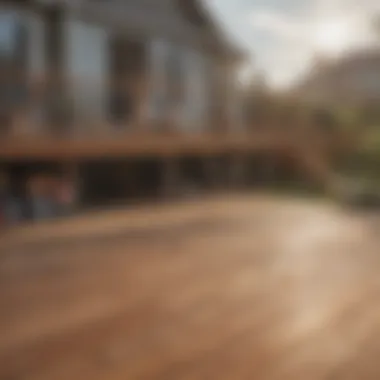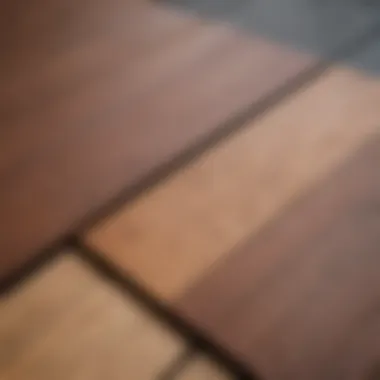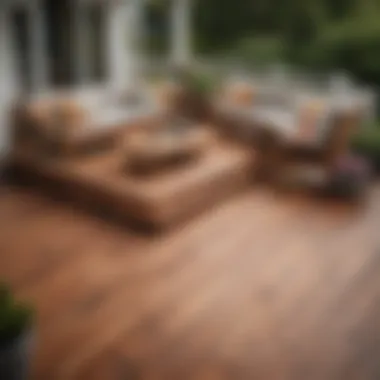Five Quarter Decking at Home Depot: A Complete Guide


Intro
In today's construction and home improvement markets, choosing the right decking material is essential for both aesthetic appeal and durability. This article delves into the specifics of five quarter decking available at Home Depot, a popular choice among homeowners. Understanding the nuances of this material can empower builders, whether they are inexperienced or seasoned, to make choices that align with their project goals.
The aim is to cover various aspects of five quarter decking, including specifications, advantages, installation techniques, and comparisons with other materials. By the end of this article, readers will be equipped with the insights necessary to navigate their options effectively.
Market Overview
The decking market is influenced by various factors, including trends, consumer demand, and new materials. Awareness of current market conditions can influence purchasing decisions significantly. Understanding these variables helps homeowners feel confident in their investments.
Current Market Sentiment
Presently, many homeowners lean towards sustainable and low-maintenance materials for their decking projects. Composite materials have gained traction, offering a blend of wood fibers and recycled plastics, appealing for their longevity and minimal upkeep. However, traditional wood remains prized for its natural look and feel, particularly in five quarter dimensions.
Major Market Indices Performance
While decking materials do not have specific indices, the overall performance of construction and home improvement sectors provides relevant indicators. Companies that produce five quarter decking typically reflect broader market trends, with sales growth during peak seasons, such as spring and summer, when outdoor projects rise.
Economic Indicators Analysis
Key economic indicators, such as housing starts and consumer confidence indices, strongly correlate with decking material sales. An increase in housing starts generally suggests more demand for home improvement materials, including decking. Economic recovery signals more investments in property renovations and constructions, making it an opportune time for buyers.
Five Quarter Decking Specifications
Five quarter decking, often one and and a quarter inches thick, offers several options. The nominal dimensions provide a solid feel underfoot and contribute to the perceived quality.
Material Choices
Popular material types for five quarter decking include:
- Pressure-Treated Lumber: Resistant to insect damage and decay, this option is budget-friendly.
- Cedar: Naturally resistant to rot, it provides both beauty and durability.
- Composite Decking: Made of wood fibers and recycled plastics, ensuring longevity.
- Ipe: A dense hardwood that is incredibly durable and weather-resistant.
Benefits of Five Quarter Decking
Choosing five quarter decking comes with specific advantages. Key benefits include:
- Sturdiness: Thicker boards provide strength and support for heavier loads.
- Visual Appeal: Many wood species have stunning natural colors and grain patterns.
- Longevity: With proper maintenance, wood decking can last for decades.
Installation Techniques
Understanding the installation process is crucial for achieving optimal results. Five quarter decking typically requires specific methods to ensure stability and durability.
Tools and Materials Required
Basic tools and materials include:
- Screws: Stainless steel or coated screws should be used to avoid corrosion.
- Fasteners: Hidden fasteners may create a seamless appearance.
- Joists: Proper spacing of joists ensures adequate support.
Step-by-Step Installation Process
- Prepare the Site: Clear the area of debris and ensure a level surface.
- Install Joists: Secure joists as the foundation for the decking.
- Lay Decking Boards: Position boards tightly together, ensuring proper spacing for expansion.
- Secure Boards: Fasten boards down using screws or hidden fasteners.
- Finishing Touches: Inspect the installation for gaps or irregularities and sand any rough edges.
Alternative Materials Comparison
Given the variety of decking materials available, a comparison is useful:
- Composite vs. Wood: Composite requires less maintenance but may lack the aesthetic warmth of wood.
- PVC Decking: Lighter and resistant to moisture but often at a higher price point than wood options.
- Aluminum: Extremely durable but can be uncomfortably hot on sunny days.


Ultimately, understanding these materials' pros and cons helps homeowners decide the best fit for their needs.
“Informed choices lead to successful investments in home improvement projects.”
The End
Five quarter decking provides a blend of durability and aesthetic appeal that can enhance any outdoor space. With insights into specifications, installation methods, and comparisons with alternatives, builders can efficiently navigate their choices at Home Depot. This guide aims to assist in understanding decking options, fostering informed decision-making, and ultimately leading to satisfying home projects.
Prologue to Five Quarter Decking
Five quarter decking is a critical topic for anyone interested in outdoor construction, particularly for those planning to build a deck in their backyard or other outdoor spaces. Understanding five quarter decking helps homeowners and contractors make informed decisions about their building materials, improving the longevity and functionality of their projects. Five quarter lumber is typically 1 inch thick, which offers a balance between sturdiness and light weight.
Definition and Characteristics
Five quarter decking is defined as boards that are nominally 5/4 inches thick. However, in the actual measurement, these boards are 1 inch thick. This thickness makes five quarter lumber appealing for decking, as it provides a solid surface without excessive weight. Furthermore, five quarter decking usually offers a smoother finish, which some find more visually appealing than thicker lumber.
The wood used for five quarter decking is often treated for protection against moisture, insects, and other elements. Treatments like pressure treatment or the use of naturally resistant species, such as cedar or redwood, enhance durability. Consequently, this type of decking often withstands the weather, making it suitable for various climates.
Common Applications
Five quarter decking is versatile and can be used in many applications. Commonly, it is utilized for patios, porches, and residential decks. Its thickness allows it to support significant weight, making it a reliable choice for high-traffic areas.
In commercial settings, five quarter decking finds use in boardwalks and outdoor venues, where aesthetics and durability are equally important. Additionally, many choose this decking for raised gardens or outdoor furniture, thanks to its robustness and appealing finish. Whether for a residential or commercial project, five quarter decking provides a reliable solution that balances form and function effectively.
Advantages of Five Quarter Decking
Five quarter decking offers several significant benefits that can be very appealing to homeowners and builders alike. Understanding these advantages is crucial for readers looking to make informed choices regarding their decking options. In this section, we will discuss durability, cost-effectiveness, and aesthetic appeal, highlighting why five quarter decking stands out.
Durability
Durability is a primary reason many choose five quarter decking. This material typically has a thicker profile than standard decking, which contributes to its ability to withstand various weather conditions. Factors such as moisture, heat, and even heavy foot traffic can take a toll on outdoor structures. However, five quarter decking’s robust nature ensures it holds up well under these challenges.
- Resistance to warping: The thickness provides resistance to warping, which is common in thinner materials.
- Long lifespan: The quality of wood used often results in a longer lifespan than alternative options, making it a valuable investment.
- Low maintenance: Because of its durability, five quarter decking requires less frequent repairs and replacements.
“Investing in durable decking means fewer worries about maintenance and replacement costs over time.”
Cost-Effectiveness
When examining cost, five quarter decking presents a compelling case. While the upfront costs may be slightly higher, it is essential to consider the long-term savings. The durability of five quarter decking means it is less likely to need replacement in the near future, which reduces overall expenses.
- Lower maintenance costs: With its robust structure, less frequent maintenance is required.
- Reduced replacement frequency: A longer-lasting material minimizes the need for regular upgrades or replacements.
- Value addition: Quality decking can enhance property value, providing great returns on investment for homeowners.
Aesthetic Appeal
Aesthetic considerations are significant when selecting any building material. Five quarter decking tends to have a pleasing appearance that can complement various architectural styles. The natural beauty of wood can create an inviting outdoor space.
- Versatile finishes: Available in various stains and finishes, making it easy to match personal tastes and existing architecture.
- Natural wood grain: Unique characteristics and textures can enhance the visual appeal.
- Enhancement of outdoor spaces: Well-maintained five quarter decking can significantly elevate the look of patios and decks, making them more enjoyable spaces.
When homeowners and builders consider these advantages, five quarter decking becomes an attractive choice. Its durability ensures longevity, while cost-effectiveness makes it financially viable. Lastly, the aesthetic appeal adds charm to outdoor environments, making it a well-rounded option for anyone looking to improve their property.
Exploring Options at Home Depot
Understanding the options available for five quarter decking at Home Depot is crucial for anyone considering a home project. Having a clear view of the brands and types of wood makes decisions more informed and practical. Five quarter decking is often chosen for its durability and aesthetic charm, but the selection from Home Depot can greatly affect the final outcome of your project.
Available Brands
Home Depot showcases several reputable brands that offer five quarter decking. Each brand has its own unique characteristics, which can influence usability and durability. Some of the notable names include:
- Trex: Known for composite materials, Trex provides an eco-friendly alternative to traditional wood. It’s resistant to fading and staining, making it ideal for various weather conditions.
- Deckorators: This brand focuses on both beauty and strength, offering a variety of styles and colors. Their products often include features that resist scratches and splits.
- Pine: A classic choice, treated Pine is affordable and easy to work with. However, it does require maintenance to ensure longevity.
- Cedar: Cedar is popular due to its natural resistance to decay. It also has a beautiful appearance that ages well over time.


Each of these brands presents different features and advantages, which should be evaluated based on specific user needs and preferences.
Types of Wood Used
The type of wood is another significant consideration when selecting five quarter decking at Home Depot. Different woods have varied properties that can impact both appearance and performance.
- Pressure-Treated Pine: This wood is commonly used for decking due to its resistance to rot and insects. The treatment process can also make it more durable against environmental stressors.
- Redwood: Known for its rich color and grain, Redwood is often chosen for aesthetic reasons. It can be more expensive than other options but provides a timeless look.
- Ipe: A dense and durable hardwood, Ipe is well-regarded in decking. It is naturally resistant to insects and decay, making it a long-lasting choice.
- Cedar: As mentioned earlier, Cedar offers both beauty and durability. It tends to be lighter and easier to work with compared to some other hardwoods.
Choosing the right type of wood is essential, as it affects not only the overall cost but also the long-term maintenance of the decking. Each wood type has its own maintenance requirements that must be taken into account.
In summary, exploring the options at Home Depot helps consumers find the best fit for their decking needs. Each brand and type of wood adds its own flavor to the project, providing a more personalized outcome.
Installation Process of Five Quarter Decking
The installation process of five quarter decking is critical to achieving a durable and aesthetically pleasing outdoor space. Proper installation ensures longevity and safety, and understanding the steps involved can save both time and money. This section delves into the preparation needed, tools required, and offers a clear step-by-step guide, making it easier for both novice and experienced builders.
Preparation of the Site
Preparing the site is the first step in a successful installation. This process involves several key activities:
- Clearing the Area: Remove any old decking materials, debris, or vegetation from the area where the new decking will be installed. Ensure the space is flat and free of obstacles.
- Measuring the Space: Accurate measurements are essential. Measure the length and width of the area to determine how much five quarter decking is required. This will help avoid over or under purchasing materials.
- Assessing Drainage: Proper drainage is important to prevent water pooling on the surface, which can lead to premature decay of the decking. Ensure that the site has adequate slopes or drainage solutions in place.
- Leveling the Ground: If the ground is uneven, consider leveling it out. Use fill dirt or a shovel to create a flat surface, which will facilitate the installation process and enhance the overall look.
Required Tools and Materials
Having the right tools and materials at hand can significantly streamline the installation process. Here’s what you will typically need:
- Tools:
- Materials:
- Circular saw or miter saw
- Drill with screw bits
- Measuring tape
- Level
- Chalk line or string
- Hammer
- Safety goggles and gloves
- Five quarter decking boards
- Decking screws (preferably corrosion-resistant)
- Substructure material (usually pressure-treated lumber)
- Joist hangers (if necessary)
- Wood sealant or protective finish
Step-by-Step Installation Guide
To ensure a smooth installation process, follow these step-by-step instructions:
- Lay Out the Framework: Begin by installing the frame or the substructure, which provides support for your decking. Use treated lumber for durability. Ensure all joists are spaced evenly.
- Cut the Decking Boards: Measure and cut the five quarter boards to fit the area. Ensure each cut is clean and precise to fit well together.
- Start Laying Boards: Begin laying the decking boards from one end of the frame to the other, leaving consistent gaps between each board for drainage and expansion.
- Secure the Boards: Use screws to attach the boards to the frame. Ensure that screws are driven in straight and flush. Avoid over-tightening, as it may split the wood.
- Trim Excess: If necessary, trim any excess boards at the edges to create a clean and polished look.
- Finishing Touches: Finally, apply sealant or a protective finish to enhance the boards' longevity and maintain their appearance.
Following these steps attentively will ensure that your five quarter decking is installed correctly, maximizing its performance and aesthetic appeal.
Maintenance Tips for Longevity
Maintaining five quarter decking is essential for extending its lifespan and preserving its aesthetic appeal. The long-term performance of your decking depends significantly on how well it is cared for. Proper maintenance not only enhances the durability of the wood but also saves costs associated with repairs or replacements. Moreover, maintaining the decking can improve safety by preventing hazards that arise from deterioration or damage.
Cleaning and Care
Regular cleaning is a fundamental aspect of decking maintenance. It is advisable to clear the surface of dirt, leaves, and other debris at least once a month. A simple sweep or blow with a leaf blower can be effective. For deeper cleaning, a mixture of water and mild detergent can be used with a soft-bristle brush. Rinse thoroughly with clean water to avoid any residue.
- Avoid harsh chemicals: Strong cleaners can damage the finish of the wood.
- Spot treat stains promptly: Any spills, especially those from food or drinks, should be cleaned immediately to prevent discoloration.
- Inspect periodically: Regularly check for any signs of mold, mildew, or water damage. Addressing these issues quickly can prevent more significant problems down the line.
By adhering to these simple cleaning practices, you help maintain the integrity of the decking and enhance its life span.
Seasonal Considerations
Different seasons can pose unique challenges to the upkeep of five quarter decking. Understanding these seasonal impacts can guide effective maintenance actions.
- Spring Cleaning: At the end of winter, inspect for any damage due to snow or ice. Remove any debris from winter and perform a thorough clean to prepare for the warmer months.
- Summer Sun: UV rays can cause fading and drying. Applying a UV-resistant sealant can help protect the decking during the sunnier months.
- Fall Leaves: As leaves begin to fall, routine cleaning becomes even more important to prevent moisture retention against the wood, which could lead to rot.
- Winter Precautions: Heavy snow accumulation can damage decking boards. It’s wise to remove snow gently to avoid splitting or cracking the wood.


By considering these seasonal factors and actively maintaining your five quarter decking, you ensure it remains a functional and attractive part of your outdoor space for years to come.
Cost Analysis
Cost analysis is a critical component when considering five quarter decking for your home improvement project. It provides a clear view of the overall financial commitment required and allows homeowners to make informed decisions based on their budgets and needs. Understanding the costs associated with materials, installation, and long-term maintenance can lead to better choices and potential savings.
Price Comparison with Alternatives
When evaluating five quarter decking, a core part of the discussion is how it stacks up against alternative materials. Here are some points to consider:
- Material Choices: Alternatives such as synthetic decking or standard dimensional lumber can often have different price structures. Five quarter decking may come at a higher upfront cost, but its durability can lead to less frequent replacement.
- Longevity: Consider how long each type of decking lasts. While the initial price may be higher, five quarter decking could save money over time due to its resistance to warping, splitting, and insect damage.
- Maintenance Costs: Products like composite decking require far less maintenance than traditional wood decking. The long-term costs need to be balanced against the initial investment.
- Installation Costs: Professional installation of five quarter decking might be more expensive than simpler alternatives, yet costs can vary based on the project’s scale.
In summary, while five quarter decking may not always be the cheapest option up front, its value can manifest through durability and lower maintenance costs over time.
Understanding Total Project Costs
The total project costs for installing five quarter decking encompass several elements. Understanding these can help in precise budgeting:
- Material Costs: Evaluate the cost per square foot of decking materials. Home Depot offers a variety, and prices can fluctuate based on the type of wood selected.
- Labor Costs: If you are hiring a contractor, labor will be a significant part of the total. Check multiple quotes to ensure you understand the range of prices in your area.
- Additional Materials: Don’t forget other materials needed for your project. This can include fasteners, joists, and sealants, which all add to the overall budget.
- Permits and Regulations: Depending on your location, local building codes might require permits that can come with a fee. It's essential to check this early in the project planning phase.
- Long-term Costs: Consider future expenses, such as maintenance and repairs, which are essential to keep your deck in good shape. Five quarter decking usually needs less maintenance than cheaper options, which is an important aspect of the cost analysis.
Regulatory Considerations
Regulatory considerations play a crucial role in the selection and installation of five quarter decking from Home Depot. Understanding relevant codes and regulations ensures safety, compliance, and longevity of your decking project. This aspect is especially vital for homeowners and builders who want to avoid potential fines or safety issues down the road.
Building Codes and Permits
Building codes are established guidelines to ensure safety and performance in construction and renovation projects. When installing five quarter decking, it is essential to familiarize yourself with your local building codes before commencing work. These codes typically include specifications for material quality, load capacity, and spacing of supports.
Obtaining a permit may be necessary, especially for significant projects or those that involve structural changes. Failing to secure the proper permits can result in penalties or even the requirement to dismantle completed work, wasting time and resources.
Here are a few key points to consider regarding building codes and permits:
- Local Variations: Building codes can vary widely by municipality. Always check with local authorities to understand what applies in your area.
- Material Standards: Ensure that the five quarter decking meets the approved standards for safety and durability as specified by local codes.
- Inspections: Many areas require inspections at different stages of the building process, including before covering the decking.
Environmental Regulations
Environmental regulations may also affect your decking installation, particularly if your project involves land disturbance or is near protected areas. These regulations aim to protect local ecosystems, waterways, and natural resources from harmful practices.
When using five quarter decking, keep in mind the following points about environmental regulations:
- Material Sourcing: Choose environmentally friendly products or FSC-certified wood to ensure sustainability.
- Runoff Management: Design your deck to avoid excessive water runoff that could harm nearby plants or wildlife.
- Waste Disposal: Follow guidelines on waste disposal during installation. Improper disposal of materials can lead to environmental damage and penalties.
Understanding these regulatory considerations can significantly impact the success of your project. By following local codes and environmental regulations, you ensure that your five quarter decking installation is safe, responsible, and compliant.
Final Thoughts on Five Quarter Decking
Five quarter decking holds significant value in both residential and commercial settings. Understanding its benefits and uses can provide clarity for those considering a decking project. The decision to choose five quarter decking over other materials often hinges on its durability, aesthetic appeal, and overall cost-effectiveness. However, a comprehensive evaluation is necessary to make the best choice.
Weighing the Benefits Against Alternatives
When assessing five quarter decking, one must carefully consider how it stacks up against alternatives like pressure-treated wood, composite materials, and cedar. Here are some points to keep in mind:
- Durability: Five quarter decking is typically thicker than standard decking. This construction often leads to longer lifespan and less susceptibility to warping or buckling.
- Aesthetic Versatility: The natural look of wood appeals to many homeowners. While alternatives might offer a different style, few replicate the authentic charm of five quarter decking.
- Maintenance Requirements: Other materials may require more upkeep, such as staining or sealing. Five quarter decking can be easier to maintain, depending on the wood species chosen.
- Environmental Impact: The sustainability of the wood is an essential aspect. Considerations about sourcing and long-term environmental effects may lead to a preference for five quarter decking over synthetic options.
This weighing of pros and cons can help buyers understand the true value of five quarter decking compared to alternatives available in the market.
Making Informed Decisions
To arrive at an informed decision about five quarter decking, it is vital to conduct thorough research and evaluation. Some factors to consider include:
- Quality of Material: Not all five quarter decking is created equal. Sourcing from reputable suppliers, such as Home Depot, is crucial for ensuring high quality.
- Budget Constraints: Establishing a solid budget before purchasing decking can prevent overspending. Compare the costs of five quarter decking to similar options to understand the financial implications.
- Project Longevity: Considering the long-term effects of choosing one material over another will influence your decision. Five quarter decking, due to its robust qualities, might lead to fewer repairs in the future.
- Installation Requirements: Assess whether you plan to do the installation yourself or hire professionals. Understanding the installation process can improve the decision-making experience.
Ultimately, by carefully considering these elements, builders and consumers can make choices that enhance the outcome of their decking projects, ensuring satisfaction for years to come.
Choosing wisely is crucial as it impacts not just the immediate aesthetics but also the long-term performance of your decking solution.



